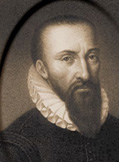Contact
Secretary General:
Zvonimir Lovrić, PhD, MD
Tel: ++385 98 281975
e-mail: cone@klovric.eu
Address of the Office:
10000 Zagreb, Croatia
Av. G. Suska 6
Ambroise Paré
 Ambroise Paré (c. 1510 – 20 December 1590) was a French surgeon, and was a pioneer in Renaissance military medicine.He was the great official royal surgeon for the kings Henry II, Francis II, Charles IX and Henry III, and is considered as one of the fathers of surgery. He was a leader in surgical techniques and battlefield medicine, especially the treatment of wounds. Although he did not comprehend the nature of microbes, he experimented with various field dressings to fight infection, and he attempted to make the treatment of soldiers a more humane process.
Ambroise Paré (c. 1510 – 20 December 1590) was a French surgeon, and was a pioneer in Renaissance military medicine.He was the great official royal surgeon for the kings Henry II, Francis II, Charles IX and Henry III, and is considered as one of the fathers of surgery. He was a leader in surgical techniques and battlefield medicine, especially the treatment of wounds. Although he did not comprehend the nature of microbes, he experimented with various field dressings to fight infection, and he attempted to make the treatment of soldiers a more humane process.
He was also an anatomist and the inventor of several surgical instruments.
Battlefield medicine
Ambroise Paré used egg yolk, oil of roses, and turpentine for war wounds instead of boiling oil and cauterization because he ran out of boiling oil while treating some patients, and used an old method he had heard before: treating the rest of the patients with the ointment of egg yolk, oil of roses and turpentine and left them overnight. When Paré returned the following morning he discovered that the soldiers treated with the boiling oil were in agony, whereas the ones treated with the ointment had recovered because of the antiseptic properties of turpentine. This proved his methods effective. However, they were not widely used until many years later. Paré also introduced the ligature of arteries instead of cauterization during amputation. To do this he designed the "Bec de Corbin" ("crow's beak"), a predecessor to modern hemostats. Although ligatures often spread infection, it still was an important breakthrough in surgical practice. During his work with injured soldiers, Paré documented the pain experienced by amputees which they perceive as sensation in the amputated limb. He believed that phantom pains occurred in the brain and are not the remnants of the limb, which is still the consensus of the medical community. Paré was also an important figure in the progress of obstetrics in the middle of the 16th century. He revived the practice of podalic version, and showed how even in cases of head presentation, surgeons with this operation could often deliver the infant safely, instead of having to dismember the infant and extract the infant piecemeal.Paré was ably seconded by his pupil Jacques Guillemeau, who translated his work into Latin, and at a later period himself wrote a treatise on midwifery. An English translation of it was published in 1612 with the title Child Birth; or, The Happy Deliverie of Women.
In 1552, Paré was accepted into royal service of the Valois Dynasty under Henry II; he was however unable to cure the king's fatal blow to the head, which he received during a tournament in 1559. Paré stayed in the service of the Kings of France to the end of his life in 1590, serving Henry II, Francis II, Charles IX, and Henry III.
According to Henri IV's Prime Minister, Sully, Paré was a Huguenot and on 24 August 1572, the day of the St. Bartholomew's Day Massacre, Paré's life was saved when King Charles IX locked him in a clothes closet. He died in Paris in 1590. While there is evidence that Paré may have been sympathetic to the Huguenot cause, he was twice married, was buried, and had his children baptized into the Catholic faith.
A collection of Paré's works was published at Paris in 1575. They were frequently reprinted, several editions appeared in German and Dutch, and among the English translations was that of Thomas Johnson (1665).
Bezoar Stone experiment
In 1565, Ambroise Paré described an experiment to test the properties of the Bezoar Stone. At the time, the bezoar stone was commonly believed to be able to cure the effects of any poison, but Paré believed this to be impossible. It happened that a cook at Paré's court was caught stealing fine silver cutlery, and was condemned to be hanged. The cook agreed to be poisoned, on the conditions that he would be given some bezoar straight after the poison and go free in case he survived. The stone did not cure him, and he died in agony seven hours after being poisoned. Thus Paré had proved that the bezoar stone could not cure all poisons.
Quotations:
- "Je le pansai, Dieu le guérit", English:"I dressed him, and God healed him."
- "Guérir quelquefois, soulager souvent, consoler toujours", English:"Cure occasionally, relieve often, console always".









